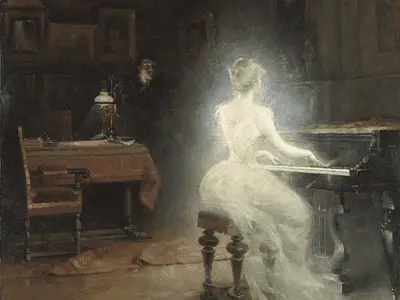
Born: 1853
Died: 1929
Summary of George Roux
George Roux was a French artist and book illustrator. He was born in 1853 and died in 1924.
The illustrations he created for Jules Verne’s science fiction novels in the series Les voyages extraordinaires are among his most well-known works. It is estimated that he illustrated 22 novels in Verne’s original editions with Pierre-Jules Hetzel. The first was L’Épave du Cynthia (The Salvage of the Cynthia, 1885) and the last was L’Étonnante aventure de la mission Barsac (The Thrilling Adventure of the Barsac Mission) (The Barsac Mission, 1919).
Among his other works, he illustrated André Laurie’s Axel Ebersen, the Graduate of Upsala, which appeared in the Boy’s Own Paper, volume 14 (1981–1982).
Unfortunately, very little is known about George Roux. Upon doing our research into George Roux, we could not find any information about his childhood, or life. Please feel free to contribute to this article so can tell all about George Roux.
Famous Art by George Roux
Spirit, Painted by George Roux
1885

The painting Spirit painted in 1885, by George Roux, is one of my favourite paintings. It’s an oil on canvas, with dimensions of 108 cm by 79 cm.
It’s in the genre of genre art also called genre views/scenes. This genre art describes a piece of art that depicts the everyday events. these scenes can be realistic to made up or romanticised by the artist.
This is my interpretation of the painting.
The painting shows a man in his study working late at night, when he looks up at a piano playing keys. A song, possibly something of meaning to him, when he sees a woman, late wife or lover, playing the piano. Or perhaps it is his figment of imagination, tiredness overtaking him. The man’s face looks of bewilderment and amazement, whilst looking at the ghostly figure.
In general, the artist uses very little negative space as the canvas is covered in detail of the scene. The artist has used a dark colour pallet of browns, black and beige with some white. I think this use of dark ‘negative’ colour may reflect the man, who may be isolating himself from the world in a dark studio, which leads him to loneliness. The background of the painting loses some of the detail, (Unclear) and is left with simple canvas painting on one wall and fairly blank. this might have been done on purpose so as to not foreshadow the subjects of the painting, the man and the ghost by the piano.
In conclusion, I think it is hauntingly beautiful.
Thank you to Greta Varpiotaite for her brilliant contribution to all about George Roux with her analysis of Spirit, Painted by George Roux
Information Citations
En.wikipedia.org, https://en.wikipedia.org/.


























